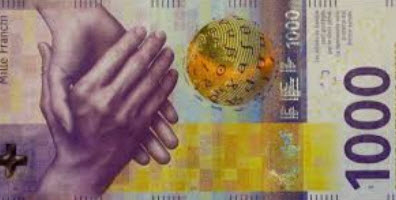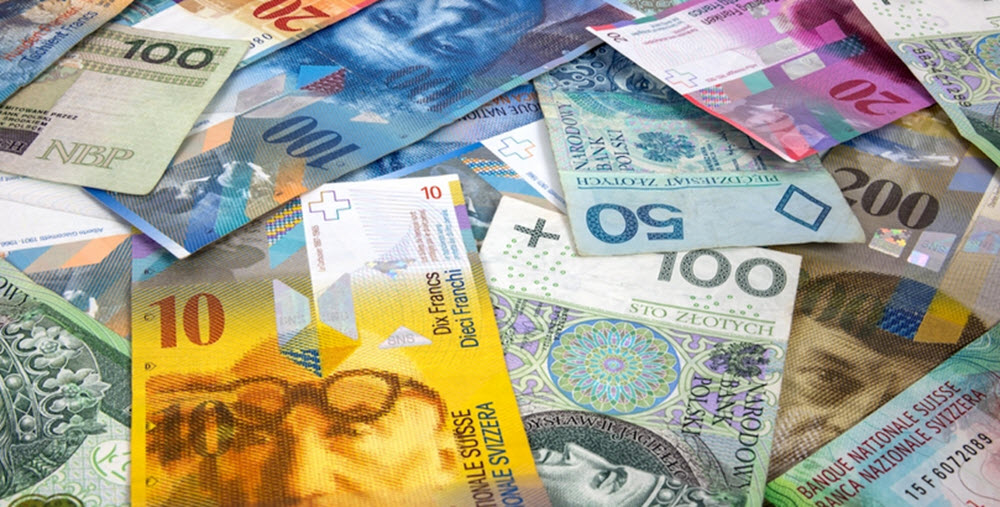In this article:
The Swiss franc (CHF) is consistently included in the top-10 list of the world’s most frequently traded currencies.
Here is a snapp-shot of data from April 2016, showing the most frequently traded currencies for that month:
| Rank | Currency |
| 1 | United States dollar |
| 2 | Euro |
| 3 | Japanese yen |
| 4 | Pound sterling |
| 5 | Australian dollar |
| 6 | Canadian dollar |
| 7 | Swiss franc |
| 8 | Renminbi |
| 9 | Swedish krona |
| 10 | New Zealand dollar |
Source: “Triennial Central Bank Survey Foreign exchange turnover in April 2016” (PDF). Bank for International Settlements.
Where is the Swiss franc used?
The Swiss franc is the official currency and legal tender of Switzerland and Liechtenstein.
It is also legal tender in the Italian exclave Campione d’Italia, which is located within the Swiss canton of Ticino.
The Swiss franc is not the official currency of the German exclave Büsuingen am Hochrhein, but it is widely accepted there and seeing prices quoted in Swiss franc instead of, or side by side with, the Euro is not uncommon.
Names
 Switzerland has four official languages: German, French, Italian, and Romansh. German is the offical language of Lichtenstein.
Switzerland has four official languages: German, French, Italian, and Romansh. German is the offical language of Lichtenstein.
- Franc suisse is the French name for the CHF.
- Franc svizzer is the is the Romansh name.
- In Italian, it’s called franco svizzero.
- In German, it’s called Schweizer Franken.
The smaller denomination, one hundredth of a franc, also have different names in the different languages.
French: 1 franc = 100 centimes (c.)
Romansh: 1 franc = 100 raps (rp.)
Italian: 1 franco = 100 centesimos (ct.)
German: 1 Franken = 100 Rappen (Rp.)
Short facts about the Swiss franc
ISO 4217 abbreviation: CHF
Numerical ISO 4217 code: 756
CH in CHF stands for Confœderatio Helvetica, and the F is for franc. Confœderatio Helvetica is the Latin name for the Swiss Confederation, which is the formal name for Switzerland.
Monetary policy
The Swiss National Bank is the central bank of Switzerland and responsible for the Swiss monetary policy.
The SNB is an aktiengesellschaft under special regulations, and has two head offices: one in Bern (de facto capital of Switzerland) and one in Zürich (the country’s largest city and one of the world’s largest financial centres).
SNB issues banknotes, while the federal min Swissmint inssues coins.
Capping and end of capping in the 2010s
In the early 2010s, the Swiss Franc became very strong against currencies such as USD and EUR. The Swiss National Bank reacted by announcing that they were prepared to buy unlimited amounts of foreign currecy to keep down the value of the franc.
Notable events that lead up to the capping
- In the summer of 2011, investors purchased large amounts of Swiss franc, hoping safeguard themselves agains the effects of the debt crisises that were in parts of Europe. By June 2011, 1 CHF was worth 1.20 USD.
- The Economist argued that the Big Mac Index for July 2011 indicated a 98% overvaluation of the Swiss franc against the USD.
- In August, the forex market price exceeded 1.30 USD per 1 CHF. This promted the Swiss National Bank to attempt to boost the franc’s liquidity, in an effort to counteract what they declared was a massive overvaluation of the Swiss franc. At this point, the market demand for Swiss franc and CHF-denominated assets was so strong that nominal short-term Swiss interest rates became negative.

The capping
In early September, the CHF/EUR exchange rate had reached 1.095 CHF per 1 EUR, and the franc appeared to be about to become 1:1 with the Euro. To counteract this, the Swiss National Bank set a minimum exchange rate of 1.20 CHF per 1 EUR (capping the franc’s appreciation) and announced that they were prepared to buy foreign currency in unlimited quantities to achieve this rate, since the strenght of the franc was a threat to the Swiss economy.
After this announcment, the franc fell down to 1.22 against the Euro within 15 minutes. The franc also lost 9% against the USD.
This very hands-on intervention by the Swiss National Bank chocked many FX traders, who up until then had seen the CHF as a safe haven.
Before the day was over, the Swiss franc had falled 8.8% against the Euro, 9.5% against the United States dollar, an a minimum of 8.2% against all the 16 most active currencies.
The 8.8% fall against the Euro was the CHF’s largest plunge ever against that currency.
End of capping
- In April 2012, the cieling level set the by Swiss National Bank was broken, but only briefly. Except for that, the franc traded below the SNB cieling until mid-January 2015.
- On 18 December, 2014, the Swiss National Bank introduced a negative interest rate on bank deposits.
- On 15 January, 2015, the Swiss National Bank ended the capping, as he Euro had been falling in value against the Swiss franc for several weeks. The change was not announced in advance, and had a very dramatic effect on both FX markets and other markets when it was unveiled. As soon as the capping was removed, the Swiss franc increased 30% in value against the Euro, although this huge increase lasted only for a few minutes. By the close of the trading day, the franc was up 23% against the Euro and 21% against the United States dollar.One of the reasons why the move had a major effect on stock markets was the assumption that a stronger CHF would wreck havoc with Swiss export industry. Share price for the Swatch Group did for instance drop 15% (in Swiss franc terms) when the SNB capping was removed.
This article was last updated on: August 8, 2019
